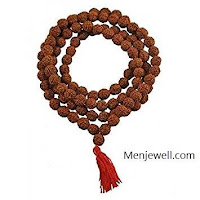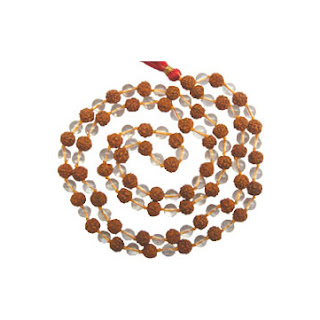10 Mukhi Rudraksha - menjewell.com
10 Mukhi Rudraksha
 This
Rudraksha is related to Laxmi Narayan and represents all the ten embodiments of
him. The person who wears this Rudraksha after proper Sidhhi ( method of
purification & charging with Mantra) get power of all the ten embodiments
of Lord Narayan. Lord Narayan removes all sins and the provider of comforts and
happiness in life. Narayan lives in the heart of the wearer of this Rudraksha;
there is no doubt about it. This Rudraksha gives good nature, wealth,
prosperity to the wearer.
This
Rudraksha is related to Laxmi Narayan and represents all the ten embodiments of
him. The person who wears this Rudraksha after proper Sidhhi ( method of
purification & charging with Mantra) get power of all the ten embodiments
of Lord Narayan. Lord Narayan removes all sins and the provider of comforts and
happiness in life. Narayan lives in the heart of the wearer of this Rudraksha;
there is no doubt about it. This Rudraksha gives good nature, wealth,
prosperity to the wearer.
Lord Vishnu,
major god of Hinduism and Indian mythology, popularly regarded as the preserver
of the universe. Some Puranic literature refers to him as the eternal,all-pervading
spirit and associates him with the primeval waters believed to have been
omnipresent before the creation of the world. So regarded, Vishnu is depicted
frequently in human form, sleeping on the great serpent Shesha and floating on
the waters. One hand holds a lotus; a second holds a conch; a third holds a
discus (which always returns by itself after being thrown); and the fourth
carries a mace. The petals of the lotus are believed to symbolize the unfolding
of creation; the conch is said to symbolize that from which all existence
originates; and the discus and the mace reputedly were obtained by Lord Vishnu as
rewards for defeating the God Indra. Lord Vishnu is said to possess also a
special sword called Nadaka and a special bow called Sarnga. His wife is
Goddess Lakshmi (also known as Shri), goddess of beauty and fortune. He rides a
huge creature, half bird and half man, called Gandara. His home is in a heaven
called Vaikuntha (where the Ganges River is believed to flow from its source at
Vishnu's feet). The god has a thousand names, the repetition of which is
regarded as an act of devotion.
The representing
deity of 10 mukhi is Lord Narayana (The Preserver). It helps the wearer to
overcome difficult times and ensures that the wearer and the family of the
wearer is protected. It creates a feeling of security. It works like a shield
on one's body and drives evils away . Wearer is protected from influence of
evil spirits , ghosts and black magic. There is no ruling planet for this bead
and it pacifies all negative planetary energy . One wears this by the blessings
of Lord Mahavishnu. Excellent for narayana bhaktas (devotees).. One gets the
power to concentrate well. Also aids in devotion and meditation.
Das Mukhi
Rudraksha is a representation of LordVishnu's ten embodiments. Lord Vishnu is the ‘preserver of this Universe’.
Rudraksha - Jablopnishad explains that this Mukhi Yamraj (the god of death),
the ‘Dashdigpal’ (the controller and guardian of ten directions) and Dash
Mahavidya (ten great learning) blesses this Rudraksha with their powers. Since
this rare bead has no ruling planet, it pacifies the power of all nine planets.
The wearer of this Rudraksha attains mental peace and solutions to all problems
without any difficulty in his life.
10 Benefits of Das Mukhi Rudraksha
- Improves your behavioural skills
- Opens the door of prosperity in your life
- Provides relief from the diseases of insomnia, instability of mind and prolonged cough
- Eliminates the fear of apparitions and ghosts
- Provides solutions for disputes and court cases
- Improves your heart beat and provides relief from heart problems
- Provides freedom from ill effects of black magic
- Provides relief from the ill-effects of nine planets
- Makes your business efficient
- Brings protection and comfort in your life

Rules for the Rudraksha:
The Wearer
of the Rudraksha should chant related Rudraksha Mantra along with Rudraksha
Utpatti Mantra (Mantra for the Rudraksha
Origin) daily at least 9 times while wearing and removing in the night before
going to sleep.
Mantra:
“ Om Hreem
Namah Namah”



Comments
Post a Comment